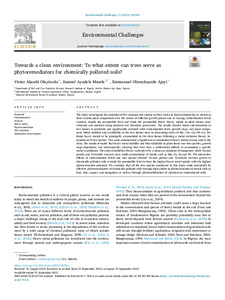| dc.contributor.author | Olayiwola, V.A. |
| dc.contributor.author | Mesele, S.A. |
| dc.contributor.author | Ajayi, E.O. |
| dc.date.accessioned | 2023-10-24T10:37:58Z |
| dc.date.available | 2023-10-24T10:37:58Z |
| dc.date.issued | 2023 |
| dc.identifier.citation | Olayiwola, V.A., Mesele, S.A. & Ajayi, E.O. (2023). Towards a clean environment: to what extent can trees serve as phytoremediators for chemically polluted soils?. Environmental Challenges, 13:100764, 1-12. |
| dc.identifier.issn | 2667-0100 |
| dc.identifier.uri | https://hdl.handle.net/20.500.12478/8307 |
| dc.description.abstract | The study investigated the potential of five common tree species in West Africa to bioaccumulate heavy metals in their various plant components over the course of different growth phases and at varying contamination levels (control, double the permissible level and triple the permissible limit). Heavy metals in plant tissues were extracted and analyzed using standard wet chemistry procedures. The results showed metal concentrations in tree tissues to positively and significantly correlate with contamination level, growth stage, and plant component. Metal mobility and availability in the tree tissues were in descending order of Mn >Zn>Cu=Pb>Cd. We found heavy metals to be principally accumulated in the stem tissues following a metal exclusion theory, independent of tree species. Tree roots demonstrated a significant accumulation of heavy metals second only to the stem. The results revealed that heavy metal mobility and bioavailability in plant tissue was tree-specific, growth stage-dependent, and metal-specific; showing that trees have a preferential affinity to accumulate a specific metal or pollutant. The study established Shorea roxborghi to be a mono-accumulator of manganese while Tectona grandis and Terminalia ivorensis were multi-accumulators of metals such as Mn, Cu, Zn and Pb. The interactive effects of contamination levels and tree species showed Tectona grandis and Terminalia ivorensis grown in chemically polluted soils at triple the permissible level to have the highest heavy metal uptake with the highest phytoextraction potential. We conclude that all the tree species considered in this study could potentially be effective phytoremediators of chemically polluted soils through their ability in phytoextraction of metals such as lead, zinc, copper, and manganese as well as through phytostabilization of cadmium in contaminated soils. |
| dc.format.extent | 1-12 |
| dc.language.iso | en |
| dc.subject | Contamination |
| dc.subject | Forestry |
| dc.subject | Heavy Metals |
| dc.subject | Phytoremediation |
| dc.subject | Soil Pollution |
| dc.subject | Sustainable Environment |
| dc.title | Towards a clean environment: to what extent can trees serve as phytoremediators for chemically polluted soils? |
| dc.type | Journal Article |
| cg.contributor.affiliation | Forestry Research Institute of Nigeria |
| cg.contributor.affiliation | International Institute of Tropical Agriculture |
| cg.contributor.affiliation | National Horticultural Research Institute, Nigeria |
| cg.coverage.region | Africa |
| cg.coverage.region | West Africa |
| cg.coverage.country | Nigeria |
| cg.coverage.hub | Headquarters and Western Africa Hub |
| cg.identifier.bibtexciteid | OLAYIWOLA:2023 |
| cg.authorship.types | CGIAR and developing country institute |
| cg.iitasubject | Climate Change |
| cg.iitasubject | Food Security |
| cg.iitasubject | Forestry |
| cg.iitasubject | Livelihoods |
| cg.journal | Environmental Challenges |
| cg.notes | Open Access Article; Published online: 23 Sep 2023 |
| cg.accessibilitystatus | Open Access |
| cg.reviewstatus | Peer Review |
| cg.usagerightslicense | Creative Commons Attribution-NonCommercial-NoDerivatives 4.0 (CC BY-NC-ND 4.0) |
| cg.targetaudience | Scientists |
| cg.identifier.doi | https://doi.org/10.1016/j.envc.2023.100764 |
| cg.futureupdate.required | No |
| cg.identifier.issue | 100764 |
| cg.identifier.volume | 13 |
| cg.contributor.acknowledgements | The authors wish to thank Prof Jamiu O. Azeez at the Federal University of Agriculture Abeokuta for his guidance during the experimentation process and for reviewing the PhD thesis from which the initial version of this manuscript was developed. |

